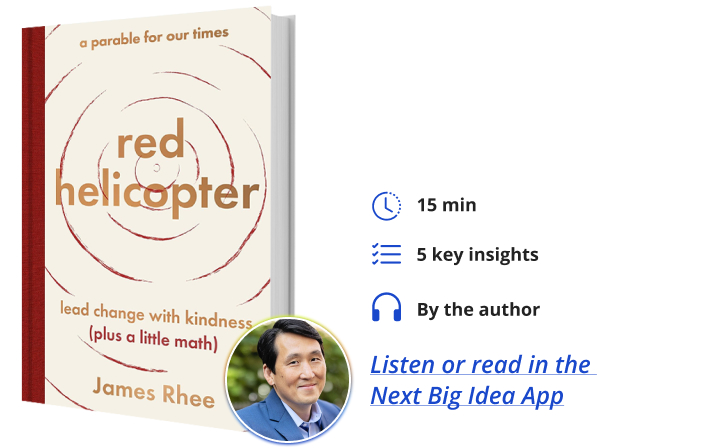James Rhee teaches at Howard University as the Johnson Chair of Entrepreneurship. He also holds appointments as a senior lecturer at MIT Sloan School of Management and Duke Law School. He has spent most of his career outside of the classroom as a longtime entrepreneur and private equity investor, particularly in the consumer retail space. He had a transformative impact as CEO of the clothing brand Ashley Stewart.
Below, James shares five key insights from his new book, Red Helicopter―A Parable for Our Times: Lead Change with Kindness (Plus a Little Math). Listen to the audio version—read by James himself—in the Next Big Idea App.

1. The impossible is possible through kindness and math.
Ten years ago, I was a private equity guy. I was an investor in Boston with very little operating experience. I had dishwashing and busboy on my resume from high school, and the company that I ended up running for what was supposed to be six months and became seven years was a company called Ashley Stewart, which had more than a 20-year track record of serving and employing predominantly plus size, moderate income, Black women in urban neighborhoods. When I arrived, the company had decades of operating losses and not-so-great relationships on Wall Street or with the financial capital markets.
Upon my arrival, the company was arguably six to ten weeks away from liquidation. The only way for me to approach the chaos in this seemingly mismatched role was to start with kindness and math. Yes, we made kindness a key underpinning of our operations. We soon discovered that the true meaning of kindness, which Rousseau and Adam Smith knew 300-plus years ago, was that kindness is fundamentally about setting up a system that invests in other human beings’ agency. We focused on creating an environment that felt safe so that people could invest in themselves, invest in others, create positive externalities, and be rewarded for it.
The other key was math—not accounting. As most mathematicians and artists know, math is an imaginative exercise. It’s a discipline found in nature that man tries to dominate but cannot. Math lives at the same transcendent levels as kindness and the laws of physics. Math seeks truth. It does not seek answers according to some accounting system or reporting requirements. By reconciling these two definitions and disciplines—kindness and math—we were forced to reconcile other seemingly irreconcilable oxymorons: imagination and execution, home life and work life, and the definitions of success: financial, organizational, systemic, life.
2. We should operate business and life like a helicopter, not an airplane.
Ask anyone: Would they want to be a helicopter or an airplane? I surmise that most people would choose to be an airplane. Airplanes go really fast, fly really high, and are very powerful. Perhaps in a more nuanced way, we hold out the hope of being a leader, being a pilot where we control the destiny of a few hundred passengers. But if you ask me, especially in this era of accelerating innovation cycles, I would rather be a helicopter.
“To be able to fly a helicopter means that you’re flying in balance.”
Helicopters can’t fly as high, they’re not as powerful, they require more maintenance, the upkeep is more expensive, and they crash more than airplanes. All that is true, but properly flown, helicopters are more agile. They can fly in six different directions. They have the gift of vertical lift, which means they don’t need a long runway to take off or to land. They can pretty much land anywhere.
Another important part of helicopters is that they can’t carry many people. In short, I think helicopters and the art of flying is a good symbol. I’ve heard that flying a helicopter is like trying to balance a marble on a sheet of glass, particularly when hovering. To be able to fly a helicopter means that you’re flying in balance. When you have balance, you are exercising true agency.
3. Agility requires balance.
We should be leading more through our balance sheet than our income statement societally, for many reasons. One, because it’s easier to measure, and the relationship seems more direct. But also because of the influence of media and technology on our short attention spans. We have primed ourselves to just focus on the income statement. In boardrooms or on squawk boxes, you hear about revenue growth or earnings growth. We never speak about the balance sheet and the investment it took to obtain that revenue and earnings growth. Instead, we focus on single and binary inputs at the income statement level.
Think about this from a country perspective. The granddaddy of all income statement measurements is GDP, founded by Simon Kuznets. When he introduced the measurement, he warned Congress not to use GDP as a single measurement of the financial and societal health of a country. But we have chosen to ignore that, just as many companies ignore what their balance sheet looks like. I’ve helped manage billions of dollars of capital, I’ve run a company in times of growth and distress, and I specialize in inflection points. It’s virtually impossible to pivot and be agile when you’re not in a position of balance. In the book, I reteach readers the principles of accounting from a first principle standpoint: from the vantage of a ten-year-old operating a lemonade stand.
I outline the limits of accounting by showing readers what is booked as an asset, what’s booked as a liability, and what things are not booked because they’re not measurable to certain accounting standards. After you go through this exercise, it will become increasingly evident that the rules of accounting are creating a system that incentivizes behaviors that we are inadvertently following. It’s sort of like pachinko, where the ball travels down the obstacles on the board, and we’re not realizing that maybe some of the grooves are shaped in ways that we don’t want them to be. We need to run our lives, businesses, and society through a balance sheet and start considering the things the rules of accounting aren’t measuring.
4. Perhaps the Korean concepts of Jeong and Han can create a more sustainable pattern of growth.
Very recently, Jensen Huang, the CEO of Nvidia, was interviewed, and his quotes about the importance of suffering went viral. I will paraphrase, but Jensen said that he looks for companies, brands, and colleagues who understand and have been through suffering. We all know that suffering goes hand in hand with joy. It’s very difficult to appreciate joy if you haven’t been through the pain of founding a business or going through a difficult period in your personal life. The Korean concepts of Jeong and Han take things a bit further.
“Growth doesn’t happen linearly for months, weeks, quarters, or years on end.”
Jeong literally means connectedness. It’s the concept of a relationship, of a feeling of mutualism that transcends time and space. It is a positive feeling, an intangible asset that defies measurement. Han is exactly the opposite. Han is an intergenerational feeling of trauma, anger, and sorrow that can’t be relieved. The concepts of Jeong and Han speak to living a balanced life or leading a company in a balanced way.
Growth doesn’t happen linearly for months, weeks, quarters, or years on end. It’s just not how growth happens in nature or our personal lives. Maybe if we think about the suffering and joy of Han and Jeong, more leadership teams will realize that some of the greatest growth trajectories of companies occur after a period of stability and equilibrium. At times, real innovation won’t show in the numbers in a punctuated way until further down the line.
5. Maybe the future of things like CSR, DEI, and ESG would better be described in a musical concept called counterpoint.
Counterpoint is a concept where the left hand and the right hand play two distinct melodies on a piano. Neither hand plays a harmony. What emerges is more beautiful than either melody apart. The song has real structural integrity. Maybe as we think about the future of inclusion and about being human to one another, both in life and at work, it would better serve us to think about our internal organizational structure as a musical composer trying to design a system where people can sing melodies. In this way, we can strive for counterpoint in the life of business and the business of life.
To listen to the audio version read by author James Rhee, download the Next Big Idea App today:































